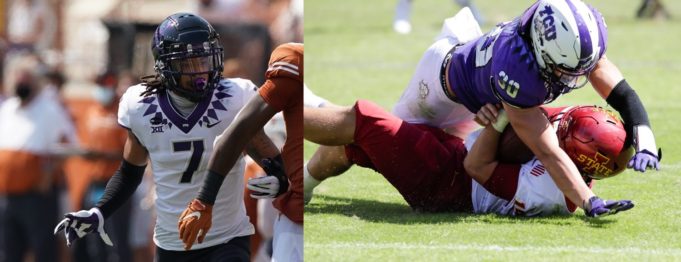The quantity of journalistic sweat that, excuse the pun, is poured into the NFL draft is enough to make even the most rabid fan’s head spin. Pseudo-scout breakdowns of individual players, teams, states, and even which high schools produce the most NFL-ready talent already dot the interwebs ad nauseam, but too many existing analyses are oversimplified, superficially sprinting past the question that plagues all sports bar debates: Which state is the real capital of football? We’re going to tackle that question and several more you didn’t ask in a special draft edition of Buck U.
The most commonly questioned correlation between the NFL and the NCAA is how many picks each conference produces. This year, the news wasn’t stellar for the Horned Frogs and friends. The Big 12 ranked fifth overall and dead last among the Power 5 with 22 players moving up. The PAC 12 sent slightly more with 28, and the SEC ran roughshod over everyone with an imposing 65 selections to the league. The Big 10 and ACC sat in a middle tier with 44 and 42 selections, respectively. This was the first year in recent memory that the conference of Texas and Oklahoma produced zero first-round selections. TCU itself sent two draftees to the pros this season, safety Trevon Moehrig in the second round to the Vegas Raiders and linebacker Garret Wallow in the fifth to the Houston Texans. It’s no surprise to see Frog defenders advancing, but second- and fifth-round selections don’t qualify for bragging rights around Fort Worth.
As far as teams go, Alabama and Ohio State tied for most selections with 10 each. Third place was another tie, this one between Georgia and Notre Dame with nine picks. The Gators and Wolverines knotted for fifth place in quantity, each with eight, and LSU was seventh with seven Tigers advancing to the paid ranks. Rounding out the Top 10 was a three-way tie between Kentucky, Penn State, and Pittsburgh with six players called. After the aforementioned, you can finally find a familiar squad as Texas and Oklahoma tied with eight other schools with five picks per. Despite the litany of SEC selections, don’t let the Aggies pile on to the SEC superiority pyramid scheme as they advanced only four.
State of the NFL
A fan of geography, the burning question in my mind is always which state truly deserves to be called the capital of football. Obviously, as Texans, we craft a strong case because football here is not a game. It’s culture, family, politics, economics, and perhaps every bit as valued as religion. But we Texans are masters of cognitive dissonance, never questioning the integrity of our own institutions, often to a fault. So is Texas really the ultimate football state? The answer is, as I discovered during my research, complicated.
I spent considerable time digging into the hometowns and high school careers of all 259 NFL draft picks (There would normally be 260, but the Vikings had to forfeit their seventh-round pick because of a previous salary cap violation.) It shouldn’t surprise anyone that Texas produced the most drafted talent this year with 34 players. You might discover figures that allege the state of Florida produced the top figure with 37 and that Texas produced only 33, but those are misleading. The IMG Academy in Bradenton, Florida, is a well-known sports magnet school that touted recruits flock toward because the team is currently ranked No. 1 in the nation. Only eight states accumulated more draft picks in total than IMG had, which was seven this year. For example, Kellen Mond — former quarterback for Texas A&M — transferred from Ronald Reagan High School in San Antonio to IMG before his senior season. Does this last-minute migration make Mond a Floridian? No. This occurrence repeated regarding several draft picks who transferred to IMG or elsewhere for one season, and I have returned them to their proper locations, where they took the majority of their high school snaps.
The adjusted results are Texas topping the charts and Florida trailing right on our spurs with 33 rookie pros. California clocked in at third with 19 and Georgia just behind the Left Coasters with 18. Our neighbor, a popular recruiting ground for the Frogs, Louisiana rounded out the top five states with 13 selections. That makes the Lone Star State unequivocally the ultimate football state, right? It depends on your perspective.
In raw numbers, Texas is leading the pack, but quality is equally if not more important than quantity. Enter: the State Power Index (SPI) to analyze my final findings. The SPI — which I made up just now — combines two score factors. The first is which round the player was drafted in, a first-round pick receiving 7 points and a second-rounder 6 all the way to a seventh-rounder receiving 1. Texas stacked the greatest score with 144 total points.
Sadly, the second factor in the SPI divides the accumulated score by the total population according to the 2010 census (the most recent reliable data available). A state’s total population is rounded up or down to the nearest whole million residents, for simplicity, and takes the form of a whole number. (Texas’ population score is 25.) The weighted per-capita breakdown shakes up the Top 5 football states significantly. California, who boasted third-most picks in quantity, falls way past even an honorable mention with a 2.1 SPI. The Tar Heel State climbs into the fifth spot with a 4.7. Texas clocks a respectable 5.8 SPI and Florida a 7.5. Georgia sits penultimate with 8, and the big surprise this year are our neighbors to the east, Louisiana, who bombed everyone with an 11.8. The boot blew my metrics away thanks to four first-round selections and a relatively small population at 25th in the country.
There was an outlier in my data in the state of Rhode Island, who with a population of 1 million and a first-round pick — their only one — locked in a 7 SPI, but we’re not going to count them, because science.
Back to Texas
Despite the Lone Star State abdicating our self-appointed crown — in large part because of our huge population, which is likely much bigger than the 2010 census figure — producing the most draft-worthy NFL players is still significant. Because of Texas’ size, it’s important that we identify which metro area is doing the best job. Using the simple scoring model from before, we’ll look specifically at DFW, Houston, and Austin. These perceived regions include outlying areas that you’d reference while talking to someone from out of state. No one knows where Frisco is. You’re from Dallas. Conroe is nice, but you’re from Houston.
DFW scored huge with 14 players selected, accounting for 60 points when factoring in their draft round. DFW players include four hometown products in Milton Williams from Crowley, Paulson Adebo from Mansfield, Baron Browning from Kennedale, and Tylan Wallace from Fort Worth’s South Hills. Houston and Harris county sent 10 players to the NFL but accumulated an impressive 48 points thanks to three first-round picks, the only ones from our state. Austin might need to reign in their real-estate prices, because they sent only three players for a total of 9 points. Maybe our capital dwellers are becoming more proficient at polo and yacht racing.
Despite all my research, the take home lessons from this data analysis aren’t surprising. We as Texans produce some of the best football talent in the country and in the greatest quantities, yet we’re unable to convince these prospects to stay and play for their local teams in great enough measure to bring an NCAA championship back to where it should live. Until we stop losing the import/export game to schools who don’t grow top-level talent in their own states, we just have to keep hoisting our imaginary draft trophy.












